How to identify scams like "Internet Corporation For Assigned Names And Numbers (ICANN)"
Phishing/ScamAlso Known As: Internet Corporation For Assigned Names And Numbers (ICANN) phishing email
Get free scan and check if your device is infected.
Remove it nowTo use full-featured product, you have to purchase a license for Combo Cleaner. Seven days free trial available. Combo Cleaner is owned and operated by RCS LT, the parent company of PCRisk.com.
What is "Internet Corporation For Assigned Names And Numbers (ICANN)"?
Our analysis of the email has shown that it is a fraudulent letter disguised as a notification from an email service provider. The scammers who created this email aim to extract personal information from recipients. It is worth noting that such emails are known as phishing emails. Recipients should know how to recognize them and ignore them.
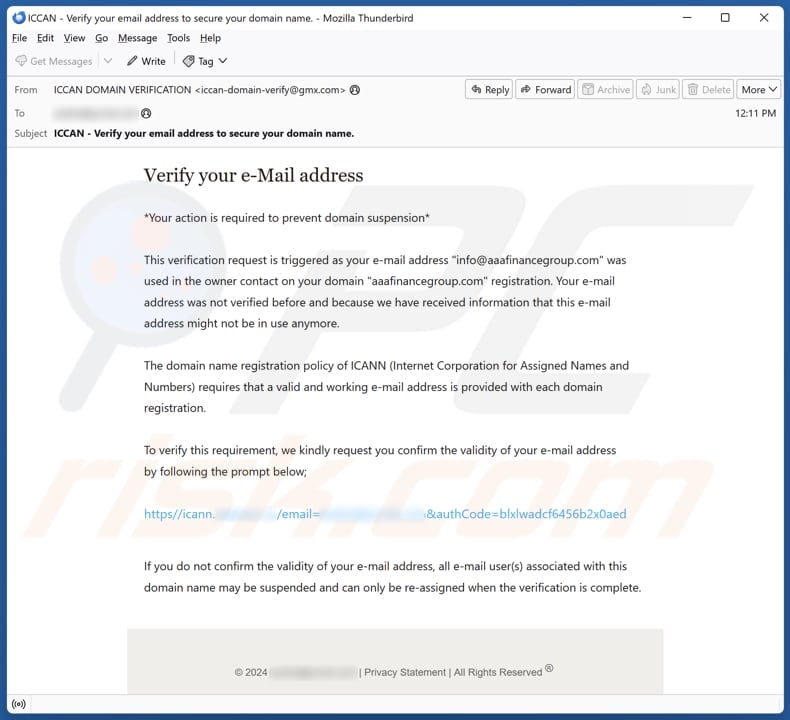
More about the "Internet Corporation For Assigned Names And Numbers (ICANN)" scam email
This scam email warns the recipient that action is needed to prevent the suspension of their domain. It falsely asserts that the recipient's email may no longer be in use, prompting them to take immediate action. The email also mentions the registration policy of ICANN (Internet Corporation for Assigned Names and Numbers), citing that a valid email address is a requirement for domain registration.
Additionally, this fraudulent message includes a warning that failure to verify the email could result in the suspension of all associated email accounts. It contains a link to confirm the validity of the email address. Clicking that link leads to a phishing page masquerading as a login portal.
This phishing page is supposed to imitate the recipient's email service provider (e.g., Google or Yahoo Mail). However, it appears that the site is not fully developed, and the imitation feature is not functioning. The purpose of this phishing site is to extract email account login credentials from unsuspecting recipients.
They can use the stolen login credentials to access email accounts and possibly other accounts if they have the same (or similar) login details. With access to these accounts, scammers may look for more sensitive information, send fraudulent messages to other people, make fraudulent purchases, etc.
Also, scammers may sell stolen login credentials or other details obtained from compromised accounts on the dark web. Thus, it is strongly recommended to examine emails before providing information and clicking links.
| Name | Internet Corporation For Assigned Names And Numbers (ICANN) Email Scam |
| Threat Type | Phishing, Scam, Social Engineering, Fraud |
| Fake Claim | Recipient's email address is not verified and the account(s) may be suspended |
| Related Domain | https-majestic-fortress-com.vercel[.]app |
| Detection Names | alphaMountain.ai (Phishing), CyRadar (Malicious), Fortinet (Phishing), Kaspersky (Phishing), Webroot (Malicious), Full List Of Detections (VirusTotal) |
| Disguise | Letter from an email service provider |
| Symptoms | Unauthorized online purchases, changed online account passwords, identity theft, illegal access of the computer. |
| Distribution methods | Deceptive emails, rogue online pop-up ads, search engine poisoning techniques, misspelled domains. |
| Damage | Loss of sensitive private information, monetary loss, identity theft. |
| Malware Removal (Windows) |
To eliminate possible malware infections, scan your computer with legitimate antivirus software. Our security researchers recommend using Combo Cleaner. Download Combo CleanerTo use full-featured product, you have to purchase a license for Combo Cleaner. 7 days free trial available. Combo Cleaner is owned and operated by RCS LT, the parent company of PCRisk.com. |
Similar scam emails in general
These emails are fraudulent messages sent by fraudsters seeking to obtain personal information (e.g., login credentials, credit card information, or identification details). These emails often masquerade as urgent communications from organizations, service providers, or other entities. Additionally, they tend include links that direct recipients to fake websites.
Examples of similar scams are "Samples Of The Product", "Internet Bank System", and "Your Mailbox Will Automatically Synchronize".
How do spam campaigns infect computers?
When cybercriminals use email to trick users into infecting computers, they send malicious files or links. These files can inject malware upon opening or performing additional steps (e.g., enabling macros commands in infected MS Office documents). Examples of files used to distribute malware are executables, PDFs, archives, script files, and ISO files.
Links in such emails can be created to open websites designed to lure users into downloading malware. They can also open sites that automatically download harmful files or programs.
How to avoid installation of malware?
Carefully examine emails before clicking links or opening attachments, particularly if they are unsolicited/irrelevant or from unfamiliar addresses. Download files or software from official websites or trusted app stores, and steer clear of unofficial sources like third-party app stores, dubious pages, or peer-to-peer networks.
Also, do not trust ads, buttons, or links on questionable websites. Ensure your software and operating system always have the latest updates and utilize a reputable security program. If you have already opened malicious attachments, we recommend running a scan with Combo Cleaner Antivirus for Windows to automatically eliminate infiltrated malware.
Text presented in the "Internet Corporation For Assigned Names And Numbers (ICANN)" email letter:
Subject: ICCAN - Verify your email address to secure your domain name.
Verify your e-Mail address
*Your action is required to prevent domain suspension*
This verification request is triggered as your e-mail address "info@aaafinancegroup.com" was used in the owner contact on your domain "aaafinancegroup.com" registration. Your e-mail address was not verified before and because we have received information that this e-mail address might not be in use anymore.
The domain name registration policy of ICANN (Internet Corporation for Assigned Names and Numbers) requires that a valid and working e-mail address is provided with each domain registration.
To verify this requirement, we kindly request you confirm the validity of your e-mail address by following the prompt below;
-
If you do not confirm the validity of your e-mail address, all e-mail user(s) associated with this domain name may be suspended and can only be re-assigned when the verification is complete.
© 2024 ******** | Privacy Statement | All Rights Reserved ®
Screenshot of the phishing website used in this campaign:
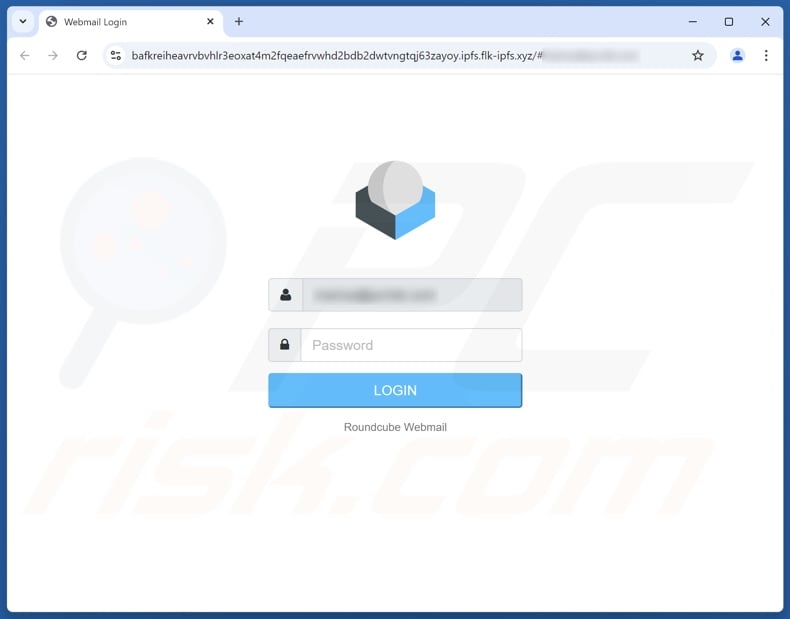
Other examples of emails from "Internet Corporation For Assigned Names And Numbers (ICANN)" spam campaign:
Sample 1:
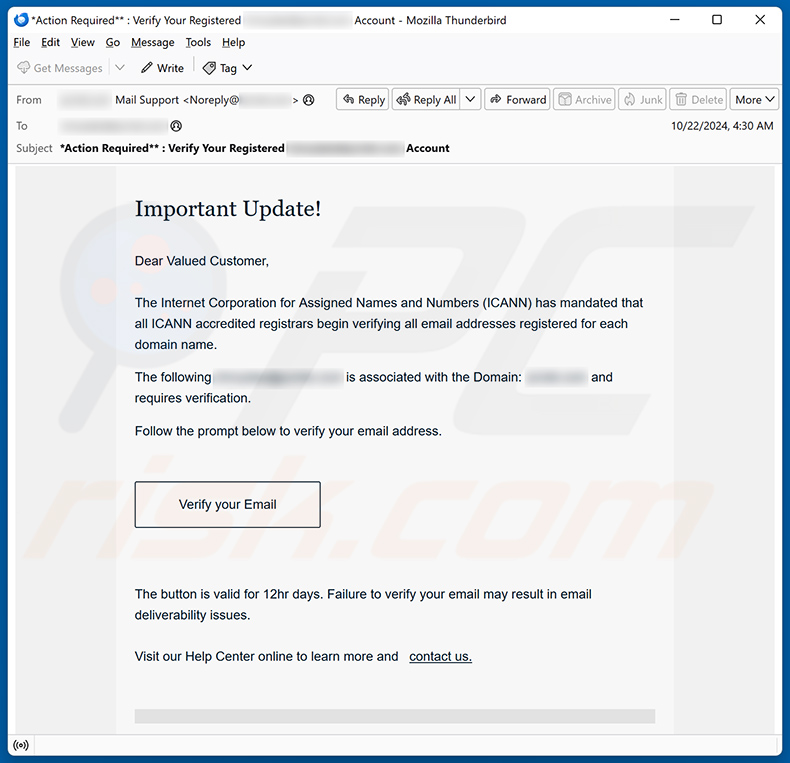
Text presented within:
Subject: *Action Required** : Verify Your Registered ******** Account
Important Update!
Dear Valued Customer,
The Internet Corporation for Assigned Names and Numbers (ICANN) has mandated that all ICANN accredited registrars begin verifying all email addresses registered for each domain name.
The following ******** is associated with the Domain: ******** and requires verification.
Follow the prompt below to verify your email address.
Verify your Email
The button is valid for 12hr days. Failure to verify your email may result in email deliverability issues.
Visit our Help Center online to learn more and contact us.
Screenshot of the phishing site promoted via this spam email:
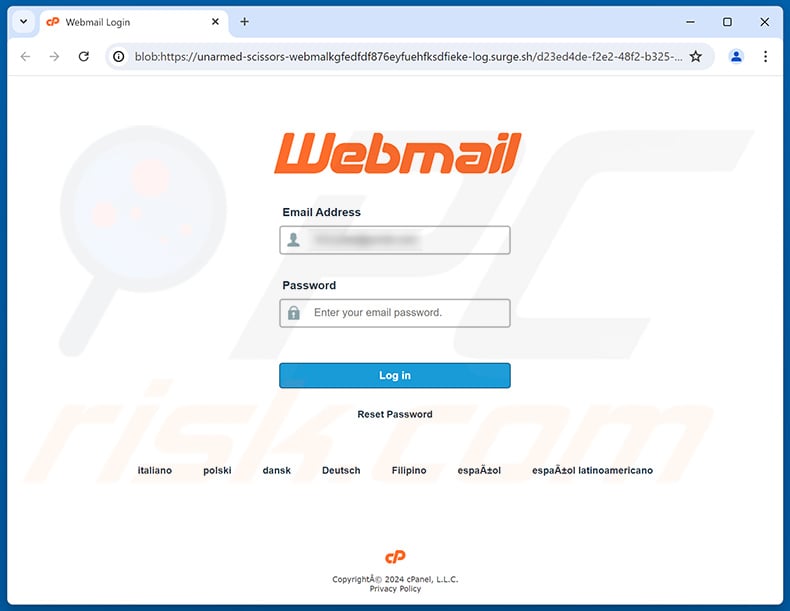
Sample 2:
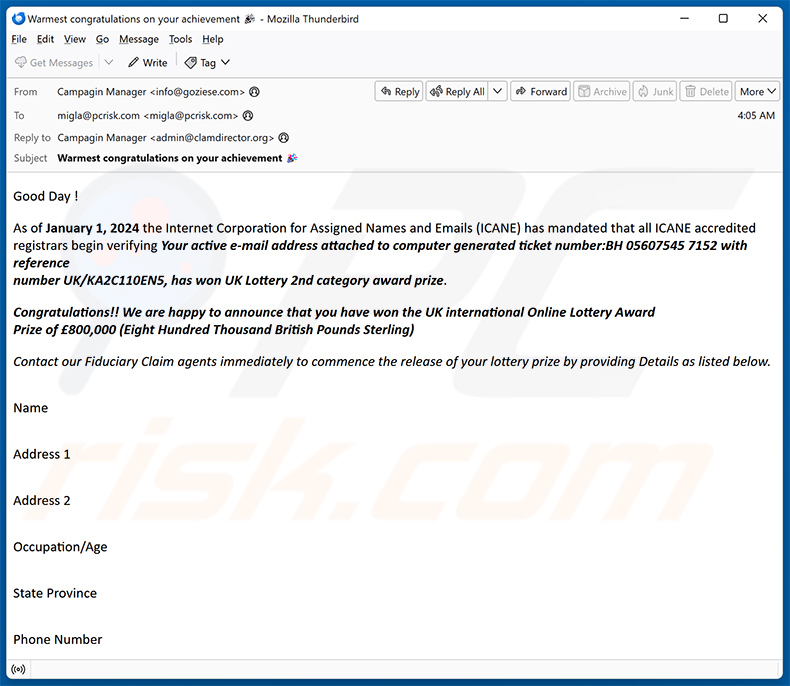
Text presented within:
Subject: Warmest congratulations on your achievement
Good Day !
As of January 1, 2024 the Internet Corporation for Assigned Names and Emails (ICANE) has mandated that all ICANE accredited registrars begin verifying Your active e-mail address attached to computer generated ticket number:BH 05607545 7152 with reference
number UK/KA2C110EN5, has won UK Lottery 2nd category award prize.Congratulations!! We are happy to announce that you have won the UK international Online Lottery Award
Prize of £800,000 (Eight Hundred Thousand British Pounds Sterling)Contact our Fiduciary Claim agents immediately to commence the release of your lottery prize by providing Details as listed below.
Name
Address 1
Address 2
Occupation/Age
State Province
Phone Number
Country
Email Address
Contact Our Accredited Agent bellow for your ClaimUK Lottery Fiduciary Agents
Mr. Jeffrey Hudson
Foreign Service Manager
Watford Regional Centre
Tolpits Lane ,Watford WD18 9RN .United Kingdom
Tel: +44 7700 009 177
E-mail: admin@clamdirector.orgThank you and Congratulation once again!
Yours faithfully,
Angela M. Johnson
(Online coordinator)
The UK Lottery International Promotion Inc
Sample 3:

Text presented within:
Subject: ICANN-Required Contact Verification
Hello ********,
ICANN-Required Contact VerificationAs part of ICANN's Registration Data Accuracy Program (RDAP) and the requirements in the Registrar Accreditation Agreement (RAA), domain registrars are required to periodically verify the accuracy of WHOIS/Registration Data contact information provided by registrants and to take action (including possible suspension) if the registrant fails to respond or the data is found to be inaccurate.
ICANN requires you to verify your domain contact.
Verify ********
Instant automatic malware removal:
Manual threat removal might be a lengthy and complicated process that requires advanced IT skills. Combo Cleaner is a professional automatic malware removal tool that is recommended to get rid of malware. Download it by clicking the button below:
DOWNLOAD Combo CleanerBy downloading any software listed on this website you agree to our Privacy Policy and Terms of Use. To use full-featured product, you have to purchase a license for Combo Cleaner. 7 days free trial available. Combo Cleaner is owned and operated by RCS LT, the parent company of PCRisk.com.
Quick menu:
- What is Internet Corporation For Assigned Names And Numbers (ICANN) phishing email?
- Types of malicious emails.
- How to spot a malicious email?
- What to do if you fell for an email scam?
Types of malicious emails:
![]() Phishing Emails
Phishing Emails
Most commonly, cybercriminals use deceptive emails to trick Internet users into giving away their sensitive private information, for example, login information for various online services, email accounts, or online banking information.
Such attacks are called phishing. In a phishing attack, cybercriminals usually send an email message with some popular service logo (for example, Microsoft, DHL, Amazon, Netflix), create urgency (wrong shipping address, expired password, etc.), and place a link which they hope their potential victims will click on.
After clicking the link presented in such email message, victims are redirected to a fake website that looks identical or extremely similar to the original one. Victims are then asked to enter their password, credit card details, or some other information that gets stolen by cybercriminals.
![]() Emails with Malicious Attachments
Emails with Malicious Attachments
Another popular attack vector is email spam with malicious attachments that infect users' computers with malware. Malicious attachments usually carry trojans that are capable of stealing passwords, banking information, and other sensitive information.
In such attacks, cybercriminals' main goal is to trick their potential victims into opening an infected email attachment. To achieve this goal, email messages usually talk about recently received invoices, faxes, or voice messages.
If a potential victim falls for the lure and opens the attachment, their computers get infected, and cybercriminals can collect a lot of sensitive information.
While it's a more complicated method to steal personal information (spam filters and antivirus programs usually detect such attempts), if successful, cybercriminals can get a much wider array of data and can collect information for a long period of time.
![]() Sextortion Emails
Sextortion Emails
This is a type of phishing. In this case, users receive an email claiming that a cybercriminal could access the webcam of the potential victim and has a video recording of one's masturbation.
To get rid of the video, victims are asked to pay a ransom (usually using Bitcoin or another cryptocurrency). Nevertheless, all of these claims are false - users who receive such emails should ignore and delete them.
How to spot a malicious email?
While cyber criminals try to make their lure emails look trustworthy, here are some things that you should look for when trying to spot a phishing email:
- Check the sender's ("from") email address: Hover your mouse over the "from" address and check if it's legitimate. For example, if you received an email from Microsoft, be sure to check if the email address is @microsoft.com and not something suspicious like @m1crosoft.com, @microsfot.com, @account-security-noreply.com, etc.
- Check for generic greetings: If the greeting in the email is "Dear user", "Dear @youremail.com", "Dear valued customer", this should raise suspiciousness. Most commonly, companies call you by your name. Lack of this information could signal a phishing attempt.
- Check the links in the email: Hover your mouse over the link presented in the email, if the link that appears seems suspicious, don't click it. For example, if you received an email from Microsoft and the link in the email shows that it will go to firebasestorage.googleapis.com/v0... you shouldn't trust it. It's best not to click any links in the emails but to visit the company website that sent you the email in the first place.
- Don't blindly trust email attachments: Most commonly, legitimate companies will ask you to log in to their website and to view any documents there; if you received an email with an attachment, it's a good idea to scan it with an antivirus application. Infected email attachments are a common attack vector used by cybercriminals.
To minimise the risk of opening phishing and malicious emails we recommend using Combo Cleaner Antivirus for Windows.
Example of a spam email:

What to do if you fell for an email scam?
- If you clicked on a link in a phishing email and entered your password - be sure to change your password as soon as possible. Usually, cybercriminals collect stolen credentials and then sell them to other groups that use them for malicious purposes. If you change your password in a timely manner, there's a chance that criminals won't have enough time to do any damage.
- If you entered your credit card information - contact your bank as soon as possible and explain the situation. There's a good chance that you will need to cancel your compromised credit card and get a new one.
- If you see any signs of identity theft - you should immediately contact the Federal Trade Commission. This institution will collect information about your situation and create a personal recovery plan.
- If you opened a malicious attachment - your computer is probably infected, you should scan it with a reputable antivirus application. For this purpose, we recommend using Combo Cleaner Antivirus for Windows.
- Help other Internet users - report phishing emails to Anti-Phishing Working Group, FBI’s Internet Crime Complaint Center, National Fraud Information Center and U.S. Department of Justice.
Frequently Asked Questions (FAQ)
Why did I receive this email?
These emails are usually sent to a large number of addresses, are generic, and do not target specific individuals.
I have provided my personal information when tricked by this email, what should I do?
If you have shared any account information, promptly update all your passwords and activate two-factor authentication wherever it is available. If you cannot access your email (or other) account, contact the service provider.
I have downloaded and opened a malicious file attached to an email, is my computer infected?
If you have opened an executable file, your computer is likely to be infected with malware. Other infected files (e.g., MS Office or PDF documents, archives) require additional user interaction to deploy malware.
I have read the email but did not open the attachment, is my computer infected?
While simply opening an email is typically safe, clicking on links or opening attachments in scam emails can result in the execution of malware.
Will Combo Cleaner remove malware infections that were present in email attachment?
Combo Cleaner is proficient in detecting and removing nearly all known threats. However, because sophisticated malware can embed itself deeply within a system, it is necessary to perform a full system scan to ensure complete removal.
Share:

Tomas Meskauskas
Expert security researcher, professional malware analyst
I am passionate about computer security and technology. I have an experience of over 10 years working in various companies related to computer technical issue solving and Internet security. I have been working as an author and editor for pcrisk.com since 2010. Follow me on Twitter and LinkedIn to stay informed about the latest online security threats.
PCrisk security portal is brought by a company RCS LT.
Joined forces of security researchers help educate computer users about the latest online security threats. More information about the company RCS LT.
Our malware removal guides are free. However, if you want to support us you can send us a donation.
DonatePCrisk security portal is brought by a company RCS LT.
Joined forces of security researchers help educate computer users about the latest online security threats. More information about the company RCS LT.
Our malware removal guides are free. However, if you want to support us you can send us a donation.
Donate
▼ Show Discussion